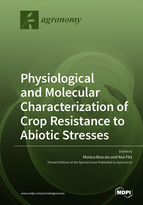Physiological and Molecular Characterization of Crop Resistance to Abiotic Stresses
A special issue of Agronomy (ISSN 2073-4395). This special issue belongs to the section "Crop Breeding and Genetics".
Deadline for manuscript submissions: 26 April 2024 | Viewed by 164773
Special Issue Editors
Interests: plant ecology; abiotic stress responses; ecology of seed germination; halophytes; stress-tolerant crops
Special Issues, Collections and Topics in MDPI journals
Interests: genetics; plant breeding
Special Issues, Collections and Topics in MDPI journals
Special Issue Information
Dear Colleagues,
Abiotic stress represents the main constraint for agriculture, affecting plant growth and productivity worldwide. Yield losses in agriculture will be potentiated in the future by global warming, increasing contamination, and reduced availability of fertile land. The challenge of present and future agriculture is to increase the food supply for a continuously growing human population under environmental conditions that are deteriorating in many areas of the world. Minimizing the effects of diverse types of abiotic stresses represent a matter of general concern. Research on all topics related to abiotic stress tolerance, from understanding the mechanism of stress responses of plants to developing cultivars and crops tolerant to stress, is a priority.
This Special Issue will focus on “Physiological and Molecular Characterization of Crop Resistance to Abiotic Stresses”. We are open to novel research, reviews and opinion articles covering all aspects of the responses and mechanisms of plant tolerance to abiotic stresses such as salinity, drought, extreme temperatures, flooding, nutrient deficiencies, high radiation, toxic compounds (heavy metals, pesticides), ozone, etc., Contributions on physiological, biochemical, and molecular studies of crops responses to abiotic stresses, description and role of stress-responsive genes, breeding of stress-tolerant varieties, marker-assisted screening of stress tolerant genotypes, genetic engineering and other biotechnological approaches to improve crop tolerance will be welcomed.
Prof. Dr. Monica Boscaiu
Dr. Ana Fita
Guest Editors
Manuscript Submission Information
Manuscripts should be submitted online at www.mdpi.com by registering and logging in to this website. Once you are registered, click here to go to the submission form. Manuscripts can be submitted until the deadline. All submissions that pass pre-check are peer-reviewed. Accepted papers will be published continuously in the journal (as soon as accepted) and will be listed together on the special issue website. Research articles, review articles as well as short communications are invited. For planned papers, a title and short abstract (about 100 words) can be sent to the Editorial Office for announcement on this website.
Submitted manuscripts should not have been published previously, nor be under consideration for publication elsewhere (except conference proceedings papers). All manuscripts are thoroughly refereed through a single-blind peer-review process. A guide for authors and other relevant information for submission of manuscripts is available on the Instructions for Authors page. Agronomy is an international peer-reviewed open access monthly journal published by MDPI.
Please visit the Instructions for Authors page before submitting a manuscript. The Article Processing Charge (APC) for publication in this open access journal is 2600 CHF (Swiss Francs). Submitted papers should be well formatted and use good English. Authors may use MDPI's English editing service prior to publication or during author revisions.
Keywords
- climate change
- drought
- salinity
- extreme temperatures
- plant breeding
- stress tolerance
- stress responses
Planned Papers
The below list represents only planned manuscripts. Some of these manuscripts have not been received by the Editorial Office yet. Papers submitted to MDPI journals are subject to peer-review.
1. Review
Tentative title:
Physiological Responses of More Important Vegetable Crops to Water Stress
Nemeskéri E. et al.
Institute of Horticulture, Szent István University, Gödöllő, H-2100 Gödöllő, Hungary
Abstract
The frequency of drought periods influences the productivity of crops under field conditions. The change in morphology and anatomy of plants has been tested during the drought stress under controlled conditions but the change in physiological processes has not been adequately studied in the field experiments. This review presents the responses of green pea, snap bean, processing tomato and sweet corn to water stress based on their stomatal behaviour, canopy temperature, chlorophyll fluorescence and chlorophyll content of leaves. These stress markers can be used for screening the drought tolerance of genotypes, the irrigation schedules or prediction of yield.
2. Terminal drought and heat stress mediate the changes in water relations, photosynthetic pigments, osmolytes accumulation and antioxidants defense mechanism in flag leaf of bread wheat
Dr. Abdul Sattar Bahauddin Zakariya University, Multan, Pakistan
Abstract: Drought and heat stress at reproductive stage are major factors limiting crop production. The study was conducted to investigate the separate and combined effect of terminal drought and heat stress on water relations, photosynthetic pigments, osmolytes accumulation and antioxidants defense mechanism in flag leaf of wheat. Experimental treatments were comprised of control (well watered and normal condition), drought stress (50% field capacity), heat stress (inside the plastic tunnel) and drought + heat (50% filed capacity and inside the plastic tunnels). Drought, heat and drought+heat stress caused a reduction in water relation (water potential, osmotic potential, turgor potential and relative water contents) and contents of photosynthetic pigments (chlorophyll a, b, a+b and a/b). The concurrent occurrence of terminal drought and heat was more severe for wheat than the single stress. However; both stresses induced the accumulation of osmolytes (proline, soluble protein and soluble sugar) as well as enhanced the activities of superoxide dismutase (SOD), peroxidase (POD), and ascorbate peroxidase (APX) over control treatment. It was concluded that combined effect of drought + heat stress was more detrimental than the individual stress and the interaction effect was hypo-additive in nature.
Key words: osmolytes, antioxidants, drought stress, heat stress, wheat, chlorophyll contents







